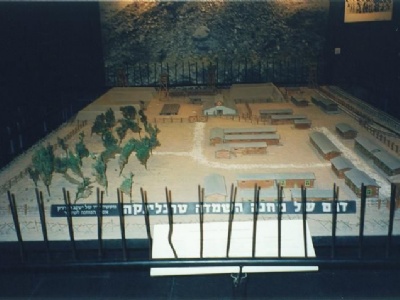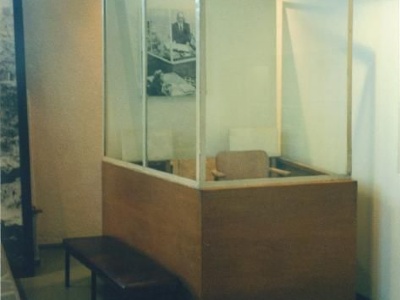Haifa
One of the most high-profile trials in post-war history was that against Adolf Eichmann in Jerusalem between April and September 1961. Not many people knew about Eichmann’s role at the end of the war because all the focus was on the more leading Nazis and the commanders of the Concentration Camps. But as the documents about the Holocaust were reviewed, the more often Eichmann’s name and signature arose. Eichmann was an Austrian who became a member of the Austrian Nazi party and SS in the early thirties. The first years after the Nazi takeover, he worked with administrative tasks within SD (Sicherheitsdienst). In 1937, he and a colleague visited Palestine to investigate the possibility of emigrating German Jews to Britain-controlled Palestine.
After Germany’s incorporation of Austria in March 1938, he was transferred to Vienna to organize the emigration of Austrian Jews to other countries. In order to induce the Jews to emigrate from Austria, he established a central agency for Jewish emigration. Immediately after the German occupation of Austria, the German Nuremberg laws were introduced. These laws stripped the Jews of their social, legal and political rights, thereby essentially forcing them to emigrate. Within six months, 50,000 of Vienna’s approximately 200,000 Jews had emigrated. Eichmann’s successful work in Vienna was noted by his superiors in Berlin. Therefore, he was tasked with establishing an agency for Jewish emigration in Berlin to accelerate Jewish emigration from both Germany and occupied Czechoslovakia.
After the outbreak of war in 1939, he became the head of RSHA Referat IV B4, which meant that he was the Gestapo expert on Jewish issues and emigration. In 1940, he proposed a plan to evacuate the Jews of the occupied territories to Madagascar off the east coast of Africa. The plan was never implemented due to logistical problems. Eichmann attended the Wannsee conference in January 1942 where some guidelines on the deportations (killings) of the Jews were discussed. In the same year, he was administratively responsible for the deportations of Jews, mainly from Western Europe, to the extermination camps in german occupied Poland. His zeal, organization, and devotion to his superiors pushed aside all his moral concerns in favor of his duties.
After the war, he was captured by the Americans who, for lack of evidence, released him. Eichmann knew that he would sooner or later would have to answer for his duties during the war. Therefore, he fled with his family via detours to Argentina where he assumed a number of different identities. As his role during the war became increasingly clear, he became one of the most wanted Nazis. In the mid-fifties, information emerged that Eichmann was in Argentina and the search was intensified. By 1960, the Israelis had identified a person named Ricardo Klement as Eichmann. However, the Israelis knew that the fascist-friendly regime in Argentina was hardly interested in extraditing Eichmann to Israel for trial. The Israeli Knesset (parliament) then approved a plan to kidnap Eichmann and bring him to Israel. There he would be brought to justice for crimes against the Jewish people.
The Israeli Security Service (Mossad) sent a team of field operatives to Argentina. They confirmed his identity and monitored Eichmann virtually around the clock and mapped his procedures to determine a suitable location for kidnapping. Eichmann lived with his family in a small house just outside Bueno’s Aries. He took the bus between home and work and the bus stop was a short walk from his house. Therefore, the team decided to kidnap Eichmann during his walk from the bus stop to the house. The kidnapping took place on May 11, 1960. He was taken to a safe house where the initial interrogations were conducted in order to establish his identity. He was then smuggled out of Argentina on a commercial aircraft of the Israeli El-Al and taken to a Jerusalem detention center.
The Israelis were very concerned that Eichmann was indeed brought to Israel and not killed by any vengeful member of the team. Therefore, there was no one within the team whose relatives were murdered by the Nazis. When Eichmann was in custody, Israel’s prime minister Ben Gurion announced to the Knesset that Eichmann was in Israeli captivity. When it became public, protests were heard from various quarters against Eichmann being kidnapped by a foreign team and that this violated international law. Israel ignored the protests. Eichmann was tried in April 1961 and charged on 15 counts all related to crimes against the Jewish people.
The trial was well-guarded by both the police and the media and was perhaps the first real TV trial. It was also during the trial that the image of the bloodthirsty and mentally disturbed Nazi beast was overthrown. Eichmann proved to be a zealous dutiful bureaucrat who claimed to have only obeyed orders in the regime in which he operated. Eichmann was an ordinary middle-level official in Nazi Germany. Had he lived in a different time, he would probably have performed his duties with the same diligence towards his superiors. Eichmann was sentenced to death and hanged in Ramla prison on June 1, 1962, without showing remorse. His body was cremated and the ashes were scattered in the Mediterranean. During the trial, Eichmann was locked in a bulletproof glass cage to prevent attempted murder. This cage can be seen in the Ghetto fighters house in Haifa.
Current status: Museum (2000).
Location: 32°57'38.2"N 35°05'43.4"E
Get there: Bus from central Haifa.
Follow up in books: Cesarani, David: Adolf Eichmann (2005).


The Museum was established by Holocaust survivors and when it opened in 1949, it was the first museum to depict the Holocaust. Another interesting object is a large model of the extermination camp Treblinka, which was made based on Treblinka survivor, Samuel Willenberg’s, testimony.